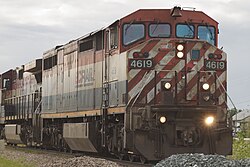This article needs additional citations for verification. (October 2024) |
| BC Rail | |
 | |
| Overview | |
|---|---|
| Parent company | BC Transportation Financing Authority (Government of British Columbia) |
| Headquarters | North Vancouver, British Columbia |
| Reporting mark | BCOL, BCIT (formerly PGE) |
| Locale | British Columbia |
| Dates of operation | February 27, 1912–present |
| Successor | Canadian National Railway (under operating lease) |
| Technical | |
| Track gauge | 4 ft 8+1⁄2 in (1,435 mm) standard gauge |
| Electrification | 1984 (Tumbler Ridge Subdivision) |
| Length | 2,320 km (1,440 mi) |
| Other | |
| Website | https://www.bcrco.com/ |
Pacific Great Eastern Railway | |||||||||||||||||||||||||||||||||||||||||||||||||||||||||||||||||||||||||||||||||||||||||||||||||||||||||||||||||||||||||||||||||||||||||||||||||||||||||||||||||||||||||||||||||||||||||||||||||||||||||||||||||||||||||||||||||||||||||||||||||||||||||||||||||||||||||||||||||||||||||||||||||||||||||||||||||||||
|---|---|---|---|---|---|---|---|---|---|---|---|---|---|---|---|---|---|---|---|---|---|---|---|---|---|---|---|---|---|---|---|---|---|---|---|---|---|---|---|---|---|---|---|---|---|---|---|---|---|---|---|---|---|---|---|---|---|---|---|---|---|---|---|---|---|---|---|---|---|---|---|---|---|---|---|---|---|---|---|---|---|---|---|---|---|---|---|---|---|---|---|---|---|---|---|---|---|---|---|---|---|---|---|---|---|---|---|---|---|---|---|---|---|---|---|---|---|---|---|---|---|---|---|---|---|---|---|---|---|---|---|---|---|---|---|---|---|---|---|---|---|---|---|---|---|---|---|---|---|---|---|---|---|---|---|---|---|---|---|---|---|---|---|---|---|---|---|---|---|---|---|---|---|---|---|---|---|---|---|---|---|---|---|---|---|---|---|---|---|---|---|---|---|---|---|---|---|---|---|---|---|---|---|---|---|---|---|---|---|---|---|---|---|---|---|---|---|---|---|---|---|---|---|---|---|---|---|---|---|---|---|---|---|---|---|---|---|---|---|---|---|---|---|---|---|---|---|---|---|---|---|---|---|---|---|---|---|---|---|---|---|---|---|---|---|---|---|---|---|---|---|---|---|---|---|---|---|---|---|---|---|---|---|---|---|---|---|---|---|---|---|---|---|---|---|---|---|---|---|---|---|---|---|---|---|---|---|---|---|
| |||||||||||||||||||||||||||||||||||||||||||||||||||||||||||||||||||||||||||||||||||||||||||||||||||||||||||||||||||||||||||||||||||||||||||||||||||||||||||||||||||||||||||||||||||||||||||||||||||||||||||||||||||||||||||||||||||||||||||||||||||||||||||||||||||||||||||||||||||||||||||||||||||||||||||||||||||||
The British Columbia Railway Company (reporting mark BCOL, BCIT), commonly known as BC Rail, is a railway in the Canadian province of British Columbia.
Chartered as a private company in 1912 as the Pacific Great Eastern Railway (PGE), it was acquired by the provincial government in 1918. In 1972 it was renamed to the British Columbia Railway, and in 1984 it took on the BC Rail branding. From 1978 to 2000, BC Rail was highly profitable, posting profits in every year throughout that period.[1]
Until 2004 it operated as the third-largest railway in Canada, providing freight, passenger, and excursion rail services throughout BC on 2,320 km (1,440 mi) of mainline track. It also ran the Royal Hudson services, as well as the premier of British Columbia's private train.
It was designated a Class II Railway until 2004. In 2004, the freight operations (including a vast amount of land, buildings, and all rolling stock) of BC Rail were leased to Canadian National Railway (CN) for an initial period of 60 years, with the exception of the Deltaport Spur, for the price of $550 million.[2]
BC Rail remains an operating Crown corporation today. It retains ownership of the entire rail bed stretching from Prince George to North Vancouver, as well as ownership of all assets leased to CN.[3] BC Rail retains significant real estate investments throughout BC, and a 40 km (25 mi) stretch of track from Roberts Bank Superport in Delta to Langley.[3] The planned sale of this 40 km (25 mi) stretch was cancelled after the initial BC Rail scandal.
- ^ McMartin, Will (2010-05-24). "How Libs Made BC Rail's True Value a Fake Train Wreck". Opinion. The Tyee. Retrieved 2019-06-25.
- ^ The Vancouver Sun http://www.canada.com/vancouversun/news/westcoastnews/story.html?id=106ef17b-3f69-4946-8132-4ce69f85d065&k=60220.
{{cite news}}: Missing or empty|title=(help)[dead link] - ^ a b "Revitilization Agreement Between British Columbia Railway and the BC Rail Partnership" (PDF). 9 July 2004. Archived from the original (PDF) on 2012-03-05. Retrieved 2010-12-29.